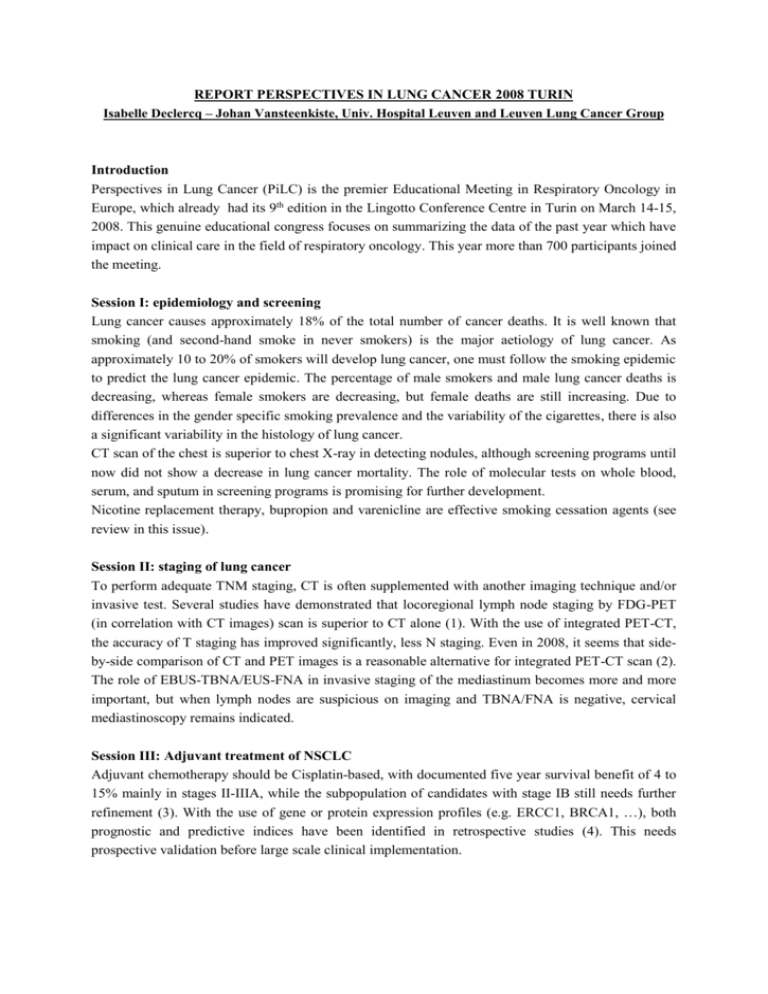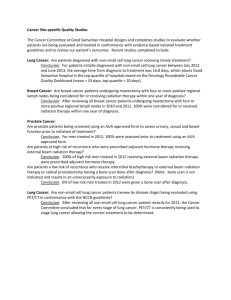Read report... - Leuven Lung Cancer Group en Longkankerpatiënt.be
advertisement

REPORT PERSPECTIVES IN LUNG CANCER 2008 TURIN Isabelle Declercq – Johan Vansteenkiste, Univ. Hospital Leuven and Leuven Lung Cancer Group Introduction Perspectives in Lung Cancer (PiLC) is the premier Educational Meeting in Respiratory Oncology in Europe, which already had its 9th edition in the Lingotto Conference Centre in Turin on March 14-15, 2008. This genuine educational congress focuses on summarizing the data of the past year which have impact on clinical care in the field of respiratory oncology. This year more than 700 participants joined the meeting. Session I: epidemiology and screening Lung cancer causes approximately 18% of the total number of cancer deaths. It is well known that smoking (and second-hand smoke in never smokers) is the major aetiology of lung cancer. As approximately 10 to 20% of smokers will develop lung cancer, one must follow the smoking epidemic to predict the lung cancer epidemic. The percentage of male smokers and male lung cancer deaths is decreasing, whereas female smokers are decreasing, but female deaths are still increasing. Due to differences in the gender specific smoking prevalence and the variability of the cigarettes, there is also a significant variability in the histology of lung cancer. CT scan of the chest is superior to chest X-ray in detecting nodules, although screening programs until now did not show a decrease in lung cancer mortality. The role of molecular tests on whole blood, serum, and sputum in screening programs is promising for further development. Nicotine replacement therapy, bupropion and varenicline are effective smoking cessation agents (see review in this issue). Session II: staging of lung cancer To perform adequate TNM staging, CT is often supplemented with another imaging technique and/or invasive test. Several studies have demonstrated that locoregional lymph node staging by FDG-PET (in correlation with CT images) scan is superior to CT alone (1). With the use of integrated PET-CT, the accuracy of T staging has improved significantly, less N staging. Even in 2008, it seems that sideby-side comparison of CT and PET images is a reasonable alternative for integrated PET-CT scan (2). The role of EBUS-TBNA/EUS-FNA in invasive staging of the mediastinum becomes more and more important, but when lymph nodes are suspicious on imaging and TBNA/FNA is negative, cervical mediastinoscopy remains indicated. Session III: Adjuvant treatment of NSCLC Adjuvant chemotherapy should be Cisplatin-based, with documented five year survival benefit of 4 to 15% mainly in stages II-IIIA, while the subpopulation of candidates with stage IB still needs further refinement (3). With the use of gene or protein expression profiles (e.g. ERCC1, BRCA1, …), both prognostic and predictive indices have been identified in retrospective studies (4). This needs prospective validation before large scale clinical implementation. Session IV: Unresectable stage III NSCLC Definitive concurrent Cisplatin-based chemoradiotherapy has become the standard approach (5). No clear evidence to date, to support the routine use of consolidation therapy in unresectable stage III disease (6). The role of PCI in locally advanced NSCLC remains unclear. Session V: Metastatic NSCLC Increasing evidence suggests that squamous cell carcinoma and adenocarcinoma of the lung are molecularly two separate entities and thus could respond differently to the same cytotoxic drugs. In a histology subset analysis of the 2nd line trial of Docetaxel vs. Pemetrexed (7), patients with adenocarcinoma had better survival than those with squamous cell carcinoma if treated with Pemetrexed, while there was no histology difference when treated with Docetaxel. A recent large phase III study also demonstrated superior outcome with Cisplatin-Pemetrexed compared to CisplatinGemcitabine in patients with adeno- or large cell carcinoma (8). Session VI/VII: targeted therapies Epidermal growth factor receptor (EGFR)-directed therapies hold great promise in the management of NSCLC. In this group, the tyrosine kinase inhibitor Gefitinib recently demonstrated comparable results to Docetaxel (9). Monoclonal antibodies to EGFR (e.g. Cetuximab, a monoclonal IgG1 antibody) has shown promising activity in phase II randomised trials in combination with platinumbased first-line chemotherapy (10). The results of the large phase III trial (FLEX) will be presented at ASCO 2008. Clinical and molecular factors may be useful to refine patient’s prognosis and prediction of treatment benefit. EGFR mutations or increased EGFR gene copy number assessed by FISH identify NSCLC with the highest chance to respond to the therapy. Results from recent large phase III trials, however, suggest that patients with clinical or biological predictors for TKI sensibility also survive longer when exposed to standard chemotherapy. Therefore, the use of prognostic and predictive tests should be validated in prospective clinical trials before widespread application. Angiogenesis is the other attractive therapeutic target. Two phase III trials (E4599 and AVAiL) showed benefit from bevacizumab (anti-vascular endothelial growth factor (VEGF) monoclonal antibody ) in combination with first-line platinum-based chemotherapy (11). Several tyrosine kinase inhibitors of the VEGFR (vascular endothelial growth factor receptor) have demonstrated activity (phase I-II trials) and are now in phase III testing (sorafenib, sunitinib, vandetanib, and others). Active cancer immunotherapy consists of specific priming of the immune system to generate specific antibodies and/or cytotoxic T cells. Because of the improved formulations, this approach has a revival. An example of such therapy is the MAGE-A3 antigen which is an antigen expressed in 35 to 40% of NSCLCs. Recent results of a phase II randomised trial with MAGE-A3 adjuvant immunotherapy after surgery for stage IB-II NSCLC showed a positive signal of activity (12), leading to ongoing phase III testing. Session VIII: pleural mesothelioma In early stage MPM, combined modality treatment could be an option. For advanced stage MPM, combination therapy with cisplatin-gemcitabine was the standard treatment. Since a phase III trial showed an increase in overall survival with the combination cisplatin-pemetrexed, this doublet has become the current standard of care. Currently the role of biologicals in advanced stage MPM is being investigated. Session IX: SCLC Currently, SCLC is often classified using the limited and extensive definitions. Based on the large IASLC database, the new TNM system will propose to use the TNM staging for SCLC as well. Cisplatin-Irinotecan, previously reported to be superior to Cisplatin-Etoposide in Japanese patients, will be the topic of SWOG S0124 presentation at ASCO 2008. Studies with targeted therapies in SCLC are in general negative and Topotecan remains the only validated second-line therapy. Prophylactic cranial irradiation was proven to reduce the incidence of symptomatic brain metastases and to prolong disease-free and overall survival in patients with extensive small-cell lung cancer who had response to initial chemotherapy (13). (1) Fischer BM, Mortensen J, Hojgaard L. Positron emission tomography in the diagnosis and staging of lung cancer: a systematic, quantitative review. Lancet Oncol 2001;2:659-66. (2) De Wever W, Ceyssens S, Mortelmans L, Stroobants S, Marchal G, Bogaert J, et al. Additional value of PET-CT in the staging of lung cancer: comparison with CT alone, PET alone and visual correlation of PET and CT. Eur Radiol 2007;17:23-32. (3) Pignon JP, Tribodet H, Scagliotti GV, Douillard JY, Shepherd FA, Stephens RJ, et al. Lung Adjuvant Cislatin Evaluation (LACE): A pooled analysis of five randomized clinical trials including 4564 patients. J.Clin.Oncol. 24, 366S. 2007 (Abstract) (4) Olaussen KA, Dunant A, Fouret P, Brambilla E, Andre F, Haddad V, et al. DNA repair by ERCC1 in non-small cell lung cancer and cisplatin-based adjuvant chemotherapy. N Engl J Med 2006;355:983-91. (5) Rowell NP, O'Rourke NP. Concurrent chemoradiotherapy in non-small cell lung cancer. Cochrane Database Syst Rev 2004;CD002140. (6) Hanna NH, Neubauer M, Ansari R, Govindan R, Bruetman D, Fisher W, et al. Phase III trial of cisplatin (P) plus etoposide (E) plus concurrent chest radiation (XRT) with or without consolidation docetaxel (D) in patients (pts) with inoperable stage III non-small cell lung cancer (NSCLC). J.Clin.Oncol. 25 Suppl, A7512. 2007. (Abstract) (7) Hanna N, Shepherd FA, Fossella FV, Pereira JR, De Marinis F, Von Pawel J, et al. Randomized phase III trial of pemetrexed versus docetaxel in patients with non-small cell lung cancer previously treated with chemotherapy. J Clin Oncol 2004;22:1589-97. (8) Scagliotti G, Parikh P, Von Pawel J, Biesma B, Vansteenkiste J, Manegold C, et al. Phase III study comparing cisplatin/gemcitabine versus cisplatin/pemetrexed in chemonaive patients with advanced non-small cell lung cancer. J Clin Oncol (in press) 2008. (9) Douillard J, Kim E, Hirsh V, Mok T, Socinski M, Gervais R, et al. Gefitinib (IRESSA) versus docetaxel in patients with locally advanced or metastatic non-small-cell lung cancer pre-treated with platinumbased chemotherapy: a randomized, open-label Phase III study (INTEREST). J.Thorac.Oncol. 2 Suppl 4, 305S-306S. 2007. (Abstract) (10) Butts CA, Bodkin D, Middleman EL, Englund CW, Ellison D, Alam Y, et al. Randomized phase II study of gemcitabine plus cisplatin, with or without cetuximab, as first-line therapy for patients with advanced or metastatic non-small cell lung cancer. J Clin Oncol 2007;25:5777-84. (11) Sandler A, Gray R, Perry MC, Brahmer J, Schiller JH, Dowlati A, et al. Paclitaxel-carboplatin alone or with bevacizumab for non-small cell lung cancer. N Engl J Med 2006;355:2542-50. (12) Vansteenkiste J, Zielinski M, Dahabre J, Linder A, Malinowski W, Jassem J, et al. Multi-center, double-blind, randomized, placebo-controlled phase II study to assess the efficacy of recombinant MAGE-A3 vaccine as adjuvant therapy in stage IB/II MAGE-A3-positive, completely resected nonsmall cell lung cancer (NSCLC): final results. J.Clin.Oncol. 25 Suppl 18, 398S. 2007. (Abstract) (13) Slotman B, Faivre-Finn C, Kramer G, Rankin E, Snee M, Hatton M, et al. Prophylactic cranial irradiation in extensive small cell lung cancer. N Engl J Med 2007;357:664-72.








